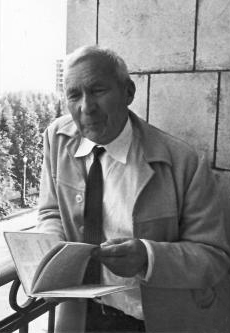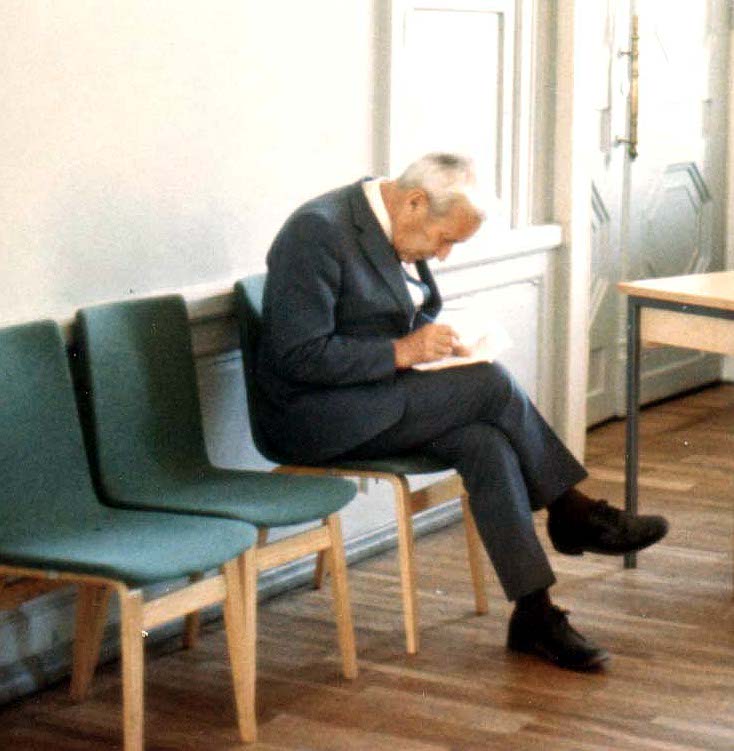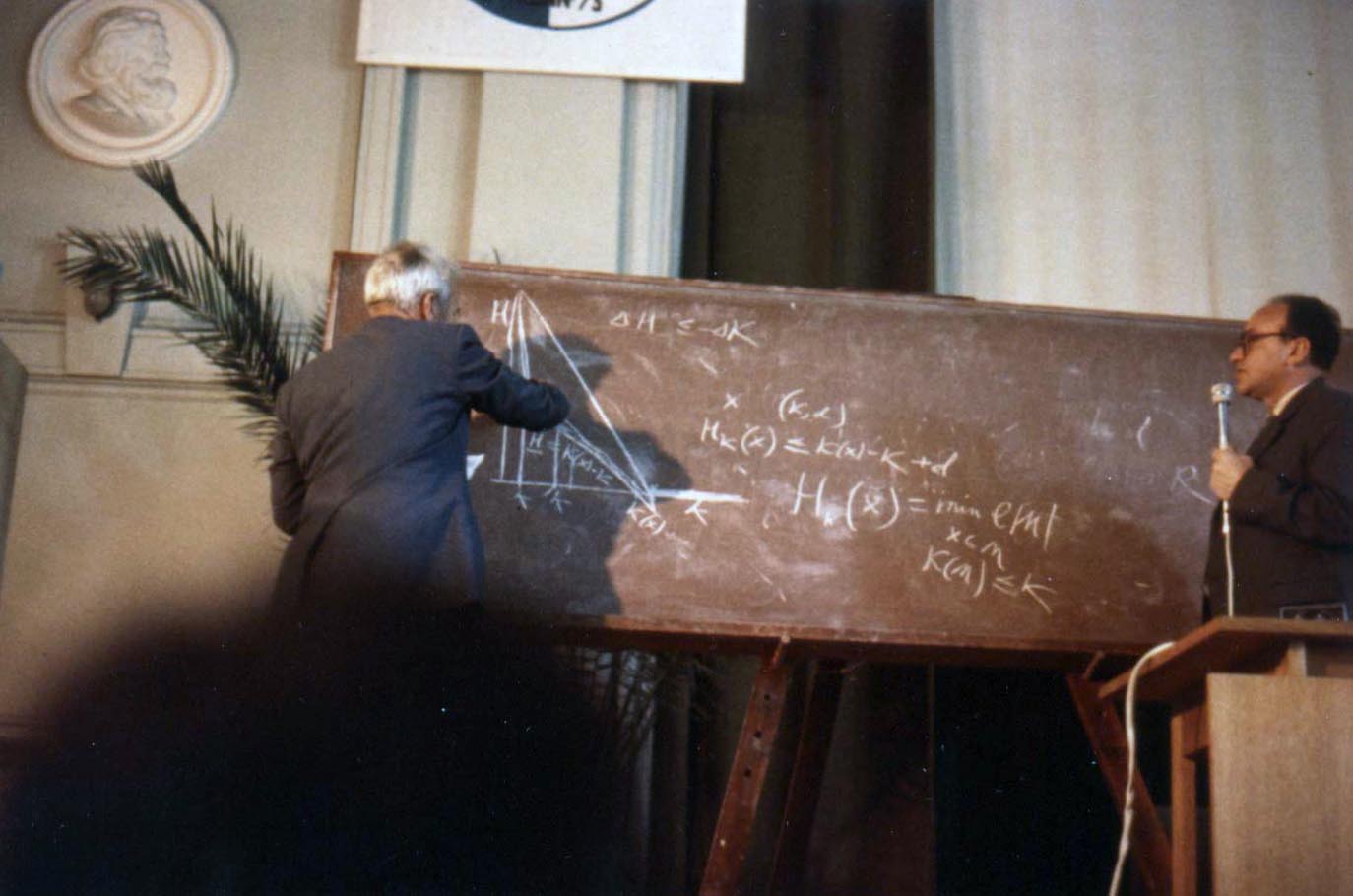1. Biography
Andrey Kolmogorov's life was marked by intellectual brilliance, significant academic achievements, and navigation through the complex political landscape of the Soviet era.
1.1. Early life and education
Andrey Nikolaevich Kolmogorov was born in Tambov, Russian Empire, on April 25, 1903. His mother, Maria Yakovlevna Kolmogorova, was unmarried and tragically died during his birth. Young Andrey was subsequently raised by two of his aunts in Tunoshna, near Yaroslavl, at the estate of his well-to-do nobleman grandfather. His father, Nikolai Matveyevich Katayev, an agronomist, had been exiled from Saint Petersburg to the Yaroslavl province due to his involvement in revolutionary movements against the Tsarist regime. Katayev disappeared in 1919 during the Russian Civil War and was presumed to have been killed.
Kolmogorov received his early education at his aunt Vera's village school. Even at a young age, his exceptional literary and mathematical talents were evident; his earliest mathematical papers were published in the school journal "The Swallow of Spring," where, at the age of five, he served as the "editor" of the mathematical section. It was in this journal that Kolmogorov's first mathematical discovery, observing the regularity in the sum of odd numbers (1 = 12; 1 + 3 = 22; 1 + 3 + 5 = 32, and so on), was published. His high literacy was noted, and he reportedly self-studied higher mathematics at 14 using an encyclopedia, filling in proofs. He also designed a perpetual motion machine as a secondary school student that his teachers could not find flaws in. In 1910, recognizing his talent, his aunt adopted him and moved with him to Moscow so he could attend gymnasium, from which he graduated in 1920.
In 1920, Kolmogorov enrolled at Moscow State University and concurrently studied at the Mendeleev Moscow Institute of Chemistry and Technology, where he also explored subjects like metallurgy and history. He arrived at Moscow University with a strong foundation in mathematics, particularly in set theory, having supplemented his knowledge from articles in the Brockhaus and Efron Encyclopedic Dictionary. During his undergraduate studies, Kolmogorov gained a reputation for his broad erudition, attending seminars by the Russian historian S. V. Bakhrushin. He was influenced by prominent Russian mathematicians such as Pavel Alexandrov, Nikolai Luzin, Egorov, Suslin, and Stepanov, being particularly impressed by Stepanov's lectures on trigonometric series. He published his first research paper on 15th and 16th-century landholding practices in the Novgorod Republic. Between 1921 and 1922, he worked on and proved several results in set theory and Fourier series theory; in the winter of 1922, he completed an academic paper on set operators, expanding upon Suslin's original concepts.
1.2. University studies and early research
In 1922, at just 19 years old, Kolmogorov achieved international recognition for constructing a Fourier series that diverges almost everywhere, a finding that surprised mathematicians and spread his name worldwide. This pivotal achievement solidified his decision to dedicate his life to mathematics.
In 1925, Kolmogorov graduated from Moscow State University and began his graduate studies under the renowned mathematician Nikolai Luzin. During this period, he developed a lifelong close friendship with Pavel Alexandrov, a fellow student of Luzin. He also began to develop an interest in probability theory alongside Aleksandr Khinchin. In the same year, 1925, he published his significant work in intuitionistic logic, "On the principle of the excluded middle," where he demonstrated that, under a specific interpretation, all statements of classical formal logic could be formulated within intuitionistic logic. He earned his Doctor of Philosophy degree from Moscow State University in 1929. In 1929, Kolmogorov and Alexandrov spent about a month on an island in Lake Sevan in Armenia during a long trip.
1.3. Overseas activities and professorship
In 1930, Kolmogorov embarked on his first extensive international trip, visiting Göttingen and Munich in Germany, and then Paris, France. In Göttingen, he engaged in various scientific discussions, particularly with Richard Courant and his students on limit theorems, where diffusion processes were shown to be limits of discrete random processes. He also discussed intuitionistic logic with Hermann Weyl and function theory with Edmund Landau. His groundbreaking work, "About the Analytical Methods of Probability Theory," was published in German in 1931. In the same year, he was appointed as a professor at Moscow State University.
1.4. Establishing the foundations of probability theory
A monumental achievement in Kolmogorov's career was the publication of his book Grundbegriffe der Wahrscheinlichkeitsrechnung (Foundations of the Theory of Probability) in 1933. This seminal work laid the modern axiomatic foundations of probability theory, integrating it with measure theory and establishing it as a rigorous mathematical discipline. This publication solidified his reputation as the world's leading expert in the field. He famously stated, "The theory of probability as mathematical discipline can and should be developed from axioms in exactly the same way as Geometry and Algebra." In 1935, Kolmogorov became the first chairman of the department of probability theory at Moscow State University. Around 1936, he also contributed to the field of ecology, generalizing the Lotka-Volterra model of predator-prey systems. In 1939, he was elected a full member (academician) of the USSR Academy of Sciences.
1.5. Major Research Areas
Kolmogorov's research extended across numerous mathematical and scientific disciplines, leaving a profound and lasting impact.
1.5.1. Probability theory
Kolmogorov's foundational work in probability theory redefined the field. In a 1938 paper, he "established the basic theorems for smoothing and predicting stationary stochastic processes," a development that had significant military applications during the Cold War. His studies on stochastic processes, particularly Markov processes, led him and the British mathematician Sydney Chapman to independently develop a pivotal set of equations, now known as the Chapman-Kolmogorov equations. These equations are fundamental in the study of how probabilities of states evolve over time in a Markov process and have applications in engineering, physics, and economics.
1.5.2. Analysis and mathematical logic
Early in his career, Kolmogorov made notable contributions to analysis, particularly in the theory of Fourier series convergence. His 1922 paper demonstrated a Fourier series that diverges almost everywhere, a surprising and influential result. In mathematical logic, his 1925 work "On the principle of the excluded middle" was significant for showing how classical formal logic statements could be recast within intuitionistic logic. He also contributed to set theory.
1.5.3. Turbulence and classical mechanics
After his initial work in probability, Kolmogorov shifted some of his research focus to turbulence, beginning his publications in this area in 1941. His work provided a theoretical framework for understanding the behavior of turbulent flows, including the concept of Kolmogorov microscales. In classical mechanics, he is most renowned for the Kolmogorov-Arnold-Moser theorem (KAM theorem), which was first presented in 1954 at the International Congress of Mathematicians. This theorem addresses the persistence of quasi-periodic motions in Hamiltonian systems under small perturbations. In 1957, working with his student Vladimir Arnold, Kolmogorov resolved a particular interpretation of Hilbert's thirteenth problem, which concerned the possibility of representing certain functions of several variables as superpositions of functions of fewer variables.
1.5.4. Algorithmic information theory and complexity
Around the mid-1950s, Kolmogorov began to develop what is now known as algorithmic complexity theory, also frequently referred to as Kolmogorov complexity. This field he co-founded with Ray Solomonoff and Gregory Chaitin provides a measure of the computational resources needed to describe a piece of data. It quantifies the intrinsic randomness or complexity of a string of information by defining it as the length of the shortest possible computer program that produces the string as its output.
1.5.5. Other contributions
Beyond these core areas, Kolmogorov's intellectual curiosity led him to make contributions to a range of other fields. These included foundational work in topology, particularly in the area of topological spaces, and further advancements in computational complexity theory. His work also extended to ecology, where he generalized the Lotka-Volterra model to describe predator-prey interactions. During World War II, he applied statistical theory to artillery fire and developed a scheme for the stochastic distribution of barrage balloons to protect Moscow from German bombers during the Battle of Moscow. In his later years, he devoted much effort to exploring the mathematical and philosophical connections between probability theory in abstract and applied domains. He also contributed numerous articles to the Great Soviet Encyclopedia.
1.6. Educational activities and students
Kolmogorov maintained a vigorous teaching routine throughout his life, both at the university level and for younger children. He was deeply involved in developing innovative pedagogies for gifted children, not only in mathematics but also in literature and music. His efforts led to reforms in Soviet gifted education, and the Moscow State University-affiliated Kolmogorov Physics and Mathematics School (физико-математическая Школа имени А. Н. КолмогороваRussian) was established in his honor.
At Moscow State University, Kolmogorov held various leadership positions, including head of departments for probability, statistics, and random processes, as well as mathematical logic. He also served as the Dean of the Moscow State University Department of Mechanics and Mathematics starting in 1931. He mentored numerous students, many of whom became prominent mathematicians, including Israel Gelfand and Vladimir Arnold.
1.7. Personal life
Kolmogorov married Anna Dmitrievna Egorova in 1942. He shared a lifelong close friendship with Pavel Alexandrov, a fellow student of Nikolai Luzin. While neither Kolmogorov nor Alexandrov openly acknowledged it, several researchers have concluded that they were in a homosexual relationship. This relationship may have influenced Kolmogorov's life in the Soviet Union; for instance, he was uniquely among top Soviet mathematicians to avoid being drafted into the postwar military effort, a circumstance some attribute to his homosexuality. From 1929, he and Alexandrov shared a home.
In 1971, Kolmogorov participated in an oceanographic expedition aboard the research vessel Dmitri Mendeleev, demonstrating his continuing engagement with diverse scientific pursuits.
1.8. The Luzin Affair
During the Great Purge in 1936, Kolmogorov's doctoral advisor, Nikolai Luzin, became a high-profile target of Stalin's regime in what became known as the "Luzin Affair." Kolmogorov, along with several other former students of Luzin, testified against their teacher, accusing him of various forms of misconduct, including plagiarism and nepotism. The hearings concluded that Luzin was a servant to "fascistoid science" and thus an enemy of the Soviet people. Although Luzin lost his academic positions, he was notably neither arrested nor expelled from the Academy of Sciences of the Soviet Union, a relatively mild punishment compared to other persecutions of the era.
The precise circumstances of the students' testimonies, including whether they were coerced by the state, remain a subject of historical debate. All parties involved, including Kolmogorov, refused to discuss the case publicly for the remainder of their lives. In 2013, Soviet-Russian mathematician Semën Samsonovich Kutateladze, after reviewing archival documents that became available in the 1990s and other surviving testimonies, concluded that Luzin's students initiated the accusations out of personal animosity, finding no definitive evidence of state coercion or support for the allegations of academic misconduct. Soviet historian of mathematics A.P. Yushkevich surmised that Stalin did not personally initiate Luzin's persecution and eventually concluded that Luzin posed no threat to the regime, which would explain the unusually lenient outcome. The affair remains a complex chapter, raising questions about academic freedom and intellectual integrity under totalitarian rule.
2. Awards and honours
Andrey Kolmogorov received numerous national and international awards and honors throughout his distinguished career, reflecting his immense contributions to mathematics and science. These include:
- Member of the Russian Academy of Sciences
- Awarded the Stalin Prize in 1941
- Elected an Honorary Member of the American Academy of Arts and Sciences in 1959
- Elected member of the American Philosophical Society in 1961
- Awarded the Balzan Prize in 1962
- Elected a Foreign Member of the Royal Netherlands Academy of Arts and Sciences in 1963
- Elected a Foreign Member of the Royal Society in 1964
- Awarded the Lenin Prize in 1965
- Elected member of the United States National Academy of Sciences in 1967
- Awarded the Wolf Prize in Mathematics in 1980
- Awarded the Lobachevsky Prize in 1986
- Awarded the Helmholtz Medal in 1975
- Awarded the title Hero of Socialist Labour
- Recipient of seven Order of Lenins
3. Legacy and impact
Kolmogorov's profound influence on mathematics and science endures through concepts, theorems, and equations that bear his name, as well as through his intellectual descendants. He is widely considered the "father of modern probability theory," and current research in mathematical probability is largely rooted in his axiomatic framework.
His lasting legacy is reflected in:
- Fisher-Kolmogorov equation
- Johnson-Mehl-Avrami-Kolmogorov equation
- Kolmogorov axioms
- Kolmogorov equations (also known as the Fokker-Planck equations in the context of diffusion and in the forward case)
- Kolmogorov dimension (upper box dimension)
- Kolmogorov-Arnold theorem
- Kolmogorov-Arnold-Moser theorem (KAM theorem)
- Kolmogorov continuity theorem
- Kolmogorov's criterion
- Kolmogorov extension theorem
- Kolmogorov's three-series theorem
- Convergence of Fourier series
- Gnedenko-Kolmogorov central limit theorem
- Quasi-arithmetic mean (Kolmogorov mean)
- Kolmogorov homology
- Kolmogorov's inequality
- Landau-Kolmogorov inequality
- Kolmogorov integral
- Brouwer-Heyting-Kolmogorov interpretation
- Kolmogorov microscales
- Kolmogorov's normability criterion
- Fréchet-Kolmogorov theorem
- Kolmogorov space
- Kolmogorov complexity
- Kolmogorov-Smirnov test
- Wiener filter (also known as Wiener-Kolmogorov filtering theory)
- Wiener-Kolmogorov prediction
- Kolmogorov automorphism
- Kolmogorov's characterization of reversible diffusions
- Borel-Kolmogorov paradox
- Chapman-Kolmogorov equation
- Hahn-Kolmogorov theorem
- Kolmogorov-Sinai entropy
- Astronomical seeing described by Kolmogorov's turbulence law
- Kolmogorov structure function
- Kolmogorov-Uspenskii machine model
- Kolmogorov's zero-one law
- Kolmogorov-Zurbenko filter
- Kolmogorov's two-series theorem
- Rao-Blackwell-Kolmogorov theorem
- Khinchin-Kolmogorov theorem
- Kolmogorov population model
- Kolmogorov's Strong Law of Large Numbers

Andrey Kolmogorov's intellectual legacy is encapsulated in a quote attributed to him, translated as: "Every mathematician believes that he is ahead of the others. The reason none state this belief in public is because they are intelligent people." The mathematician Vladimir Arnold, one of Kolmogorov's students, famously remarked: "Kolmogorov - Poincaré - Gauss - Euler - Newton, are only five lives separating us from the source of our science," underscoring the profound and continuous influence of Kolmogorov's work on the development of mathematics.


Kolmogorov's work continues to be a cornerstone for research in various fields, from pure mathematics to applied sciences, underscoring his position as one of the most influential mathematicians of the 20th century.
4. Selected works
Andrey Kolmogorov's extensive body of work includes groundbreaking books, influential papers, and widely used textbooks. A comprehensive bibliography of his publications appeared in the Annals of Probability in July 1989.
His most notable works include:
- Grundbegriffe der Wahrscheinlichkeitsrechnung (Berlin: Julius Springer, 1933).
- Translated into English as Foundations of the Theory of Probability (New York: Chelsea, 1956). This work is considered the cornerstone of modern probability theory.
- "On the principle of the excluded middle" (1925), a key contribution to intuitionistic logic.
- "On Tables of Random Numbers" (1963).
- Selected works of A.N. Kolmogorov, edited by V. M. Tikhomirov and translated by V. M. Volosov, 3 volumes (Dordrecht: Kluwer Academic Publishers, 1991-1993).
- Volume I: Mathematics and Mechanics
- Volume II: Probability Theory and Mathematical Statistics
- Volume III: Information Theory and the Theory of Algorithms
- Selected works, 6 volumes (Moscow, 2005, in Russian).
His influential textbooks include:
- With B. V. Gnedenko: Limit distributions for sums of independent random variables (1954).
- With S. V. Fomin: Elements of the Theory of Functions and Functional Analysis (published in English in 1999 and 2012) and Introductory real analysis (1975).
5. Death
Andrey Nikolaevich Kolmogorov passed away in Moscow, Soviet Union, on October 20, 1987, at the age of 84. His remains were interred in the Novodevichy Cemetery, a resting place for many distinguished figures in Russian and Soviet history.